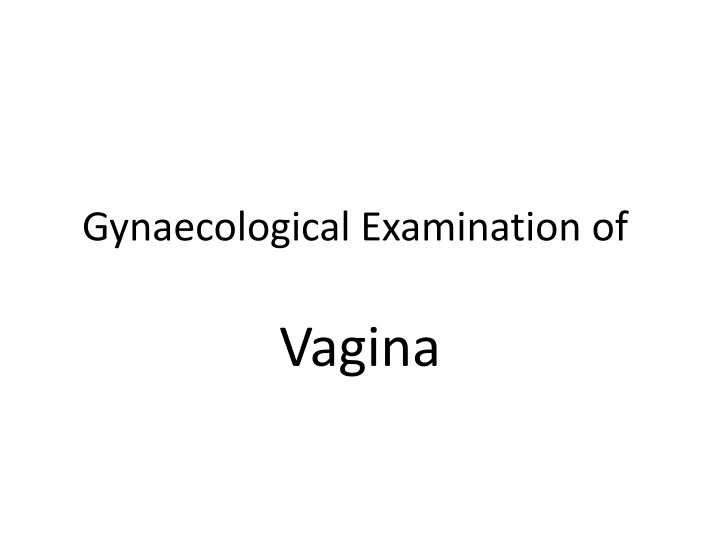Gynaecological Examination of Vagina
Gynaecological examination of the vagina in animals, including the materials needed and the procedure involved. It highlights the importance of recognizing physiological and pathological conditions in the vagina. Additionally, it discusses the collection of genital discharge for examining different types of infections and determining the severity of conditions in animals. The detailed steps, precautions, and interesting facts provided offer valuable insights into these veterinary practices.
Download Presentation

Please find below an Image/Link to download the presentation.
The content on the website is provided AS IS for your information and personal use only. It may not be sold, licensed, or shared on other websites without obtaining consent from the author.If you encounter any issues during the download, it is possible that the publisher has removed the file from their server.
You are allowed to download the files provided on this website for personal or commercial use, subject to the condition that they are used lawfully. All files are the property of their respective owners.
The content on the website is provided AS IS for your information and personal use only. It may not be sold, licensed, or shared on other websites without obtaining consent from the author.
E N D
Presentation Transcript
OBJECTIVE: To know the physiological and pathological condition of vagina. MATERIALS REQUIRED : Vaginal speculum, liquid paraffin, soap, water etc.
PROCEDURE: . 1.Restrain the cow in a crate. 2.Clean the vulva and adjacent parts with cotton dipped in normal saline or antiseptic solution. 3.Lubricate the sterilized vaginal speculum with liquid paraffin or soap water.
4.Insert the speculum through the vulva into vagina while keeping the jaws of speculum closed to avoid injury. 5.Turn the handle of vaginal speculum either downward upward and open the jaws. 6.Use torch to observe the anterior part of vagina and outer part
Note the finding like discharge, vaginitis, abscess, tumour, cervix (open or closed), cervicitis etc. Remove the speculum in an open fashion
INTERESTING FACTS Speculum examination is totally contra- indicated in pregnant animals and in animals suffering from severe vaginitis and other painful conditions. Vaginal examination ,Al or intrauterine treatment is contraindicated when the vulvar lips are wet or soiled.
Collection of genital discharage OBJECTIVE: To examine the genital discharge to have an idea about different types of infections, severity of condition, diagnosis and its treatment.
MATERIALS REQUIRED Catheter, pipette, cotton gauze, syringe and sterilized bottle.
METHODS : A. By back racking - 1.After inserting the hand into rectum, slightly lift the uterus and cervix upward and massage in backward direction. 2.Thereafter, massage backwardly to the vagina through rectal wall which will result in flow of cervical mucus through the vulvar lips.) 3.Collect the discharge in a wide-mouthed sterilized test tube. 4.Cut the discharge with the help of scissors when it remains hanging.
B. By catheter/pipette: Introduce the catheter into vagina (anterior part) or cervix or from where genital discharge has to be collected. Suck the mucus with the help of syringe which remains attached to the other end of catheter or pipette.
C. Tampon method: Take a sterile gauze tampon of about 1 g and attach a stringto it. Insert the sterilized gauze tampon into the vagina. Leave the tampon in the vagina for 20 min.
Examination of Cervico- Vaginal Mucus Sample Examination of cervico-vaginal mucus sample help in the assessment of physio-pathological condition of female genital organs.
Colour Transparent - Normal (in estrus period). Scanty reddish colour discharge - Metoestrus phase Opaque or transparent with flakes - Mild infection
Consistency Thin watery - Early oestrus Viscous and ropy - Mid heat Thick - Late heat
odour Normally, genital discharge is odourless. However, foul smelling odor generally indicates severe metritis withsystemic involvement with possible retention of fetal membrane. or some fetal parts in the uterus. It is usually found in case ofpost- parturient disorder.
pH The pH of genital discharge can be recorded by an ordinary. pH indicator paper or using pH meter. The normal pH of genital discharge ranges from 6.5 to 7.4. A higher pH indicates presence of infection.
White side test : Take 1 ml. cervical mucus in a sterilized test tube. Add 1 ml 5% sodium hydroxide solution to it. Heat the mixture upto its boiling point. Interpretation Dark yellow colour Clinical metritis

